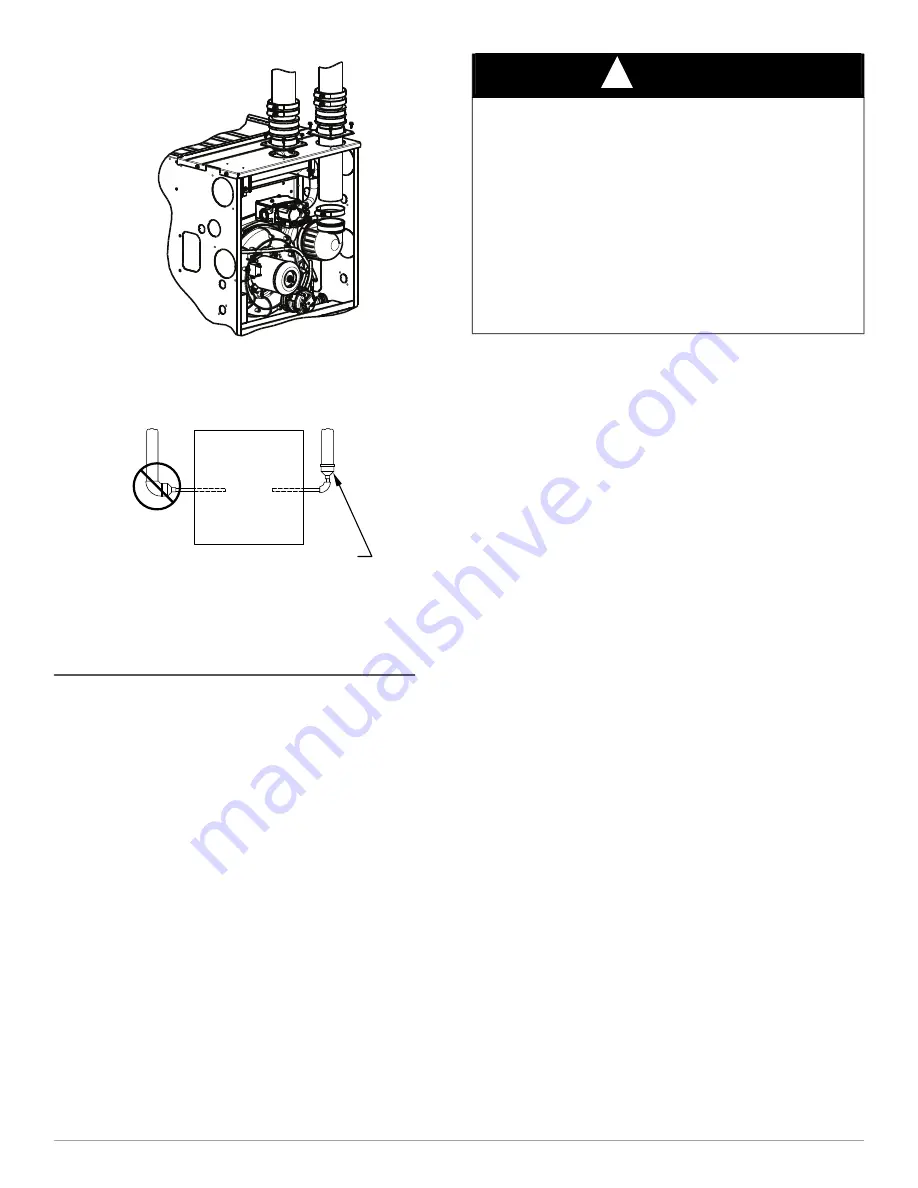
59CU5A: Installation, Start-up, Operating and Service and Maintenance Instructions
Manufacturer reserves the right to change, at any time, specifications and designs without notice and without obligations.
35
A12220
Fig. 50 – Sample Inlet Air Pipe Connection for Polypropylene
Venting Systems
A93034
Fig. 51 – Combustion Air and Vent Pipe Diameter Transition
Location and Elbow Configuration
Recommended Combustion Air Inlet Moisture Trap
Recommended to prevent moisture from trickling into the furnace
vestibule, a trap can be installed in the intake air pipe near the furnace.
To prevent moisture, connecting a drain line to the trap is recommended
as trace amounts of moisture will evaporate into the intake air stream. If
the combustion air inlet is located near a moisture exhaust duct, or there
are other concerns of excessive moisture being drawn into the
combustion air inlet, it is encouraged to connect a drain line to the trap.
The trap can be constructed from a running tee of the same diameter of
the intake air pipe with
EITHER
a removable cap attached to a 6-inch
long pipe connected to the tee or the External Vent Trap Kit to help
prevent contaminants from entering the furnace, see
The External Vent Trap Kit accessory may be used as a trap for the
combustion air inlet pipe if a large amount of moisture must be removed.
The drain line may be connected to the same drain as the furnace
condensate and the evaporator coil condensate line
ONLY
if the inlet air
trap drain and the evaporator coil drain empty into an open segment of
pipe above the drain. The drain line must be connected downstream of
the condensate trap float switch, see
. When using the External
Vent Trap Kit, refer to those instructions for proper drain connections.
The tee may also be connected to the intake air pipe on the side of the
casing, see
In any configuration, it will be necessary to add the equivalent length of
the tee (15 feet/5 M) to the Total Equivalent Vent Length of the venting
system.
ADDITIONAL INFORMATION FOR
The measured length of pipe used in a single or 2-pipe termination is
included in the total vent length. Include deductions from the Maximum
Equivalent Vent Length (MEVL) contained in the Venting Tables for
elbows and flexible vent pipe. Factory accessory concentric vent
terminations or pipe lengths and elbows used for “standard” vent
terminations do not require a deduction from the Maximum Equivalent
Vent Length. See vent termination figures, see
. Include a
deduction for a Tee when used for Alberta and Saskatchewan
terminations.
NOTE:
Polypropylene venting systems MAY require additional
deductions from the MEVL, or additions to the TEVL, for vent
terminations and flexible pipe sections. See the polypropylene venting
system manufacturer’s instructions for details on equivalent lengths of
vent terminations and flexible vent pipes, and for calculating total vent
lengths.
To calculate the Total Equivalent Vent Length (TEVL) of the venting
system:
1. Measure the individual distance from the furnace to the termination
for each pipe.
2. Count the number of elbows for each pipe.
3. For each pipe, multiply the number of elbows by the equivalent
length for the type of elbow used. Record the equivalent length of
all the elbows for each pipe.
4. If a Tee is used on the termination (Alberta and Saskatchewan,
when required) record the equivalent length of the Tee used.
5. Calculate Total Equivalent Vent Length by adding the equivalent
lengths of the fittings to the lengths of the individual vent and
combustion air pipes.
6. When using polypropylene venting systems with flexible vent
pipes, perform adjustments for the equivalent length of the flexible
vent pipe to the calculated total equivalent venting system length.
See the polypropylene vent system manufacturer’s instructions for
details.
7. Select a diameter of vent pipe (
) and note the Maximum
Equivalent Vent Length (MEVL) shown for that application for that
specific furnace input size. Compare the Total Equivalent Vent
Length (TEVL) to the MEVL:
8. If the Total Equivalent Vent Length is
shorter
than the Maximum
Equivalent Vent Length for the diameter of pipe chosen, then that
diameter of pipe selected may be used.
9. If the Total Vent Length is
longer
than the Maximum Equivalent
Vent Length for the diameter of pipe chosen, that diameter pipe
EXAMPLE FOR
UPFLOW INSTALLATIONS.
MAY BE APPLIED TO
OTHER CONFIGURATIONS.
FURNACE
NOT IN
HORIZONTAL
SECTION
PIPE DIAMENTER
TRANSITION IN
SECTION
NOTICE
!
POLYPROPYLENE VENTING SYSTEMS
Polypropylene venting systems include flexible vent pipe. These flexi
-
ble vent pipes have a different equivalent vent length than straight sec
-
tions of PVC/ABS DWV vent pipe. Be sure to make the appropriate
deductions from the Maximum Equivalent Vent Length (MEVL), or
additions to the Total Equivalent Vent Length (TEVL), when applying
flexible vent pipes in polypropylene venting systems. See the polypro
-
pylene vent system manufacturer’s installation instructions for details.
When using metric-sized venting systems, use these equivalencies for
obtaining the proper MEVL from the Tables:
Use 2” Vent Tables for 60 mm (o.d.) vent systems
Use 3” Vent Tables for 80 mm (o.d.) vent systems
Use 4” Vent Tables for 100 mm (o.d.) vent systems
















































